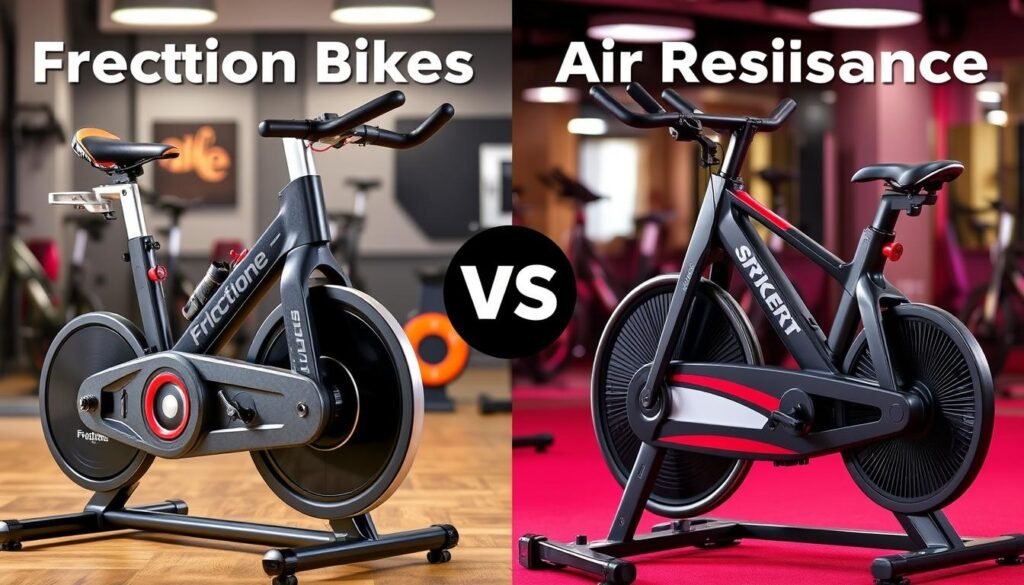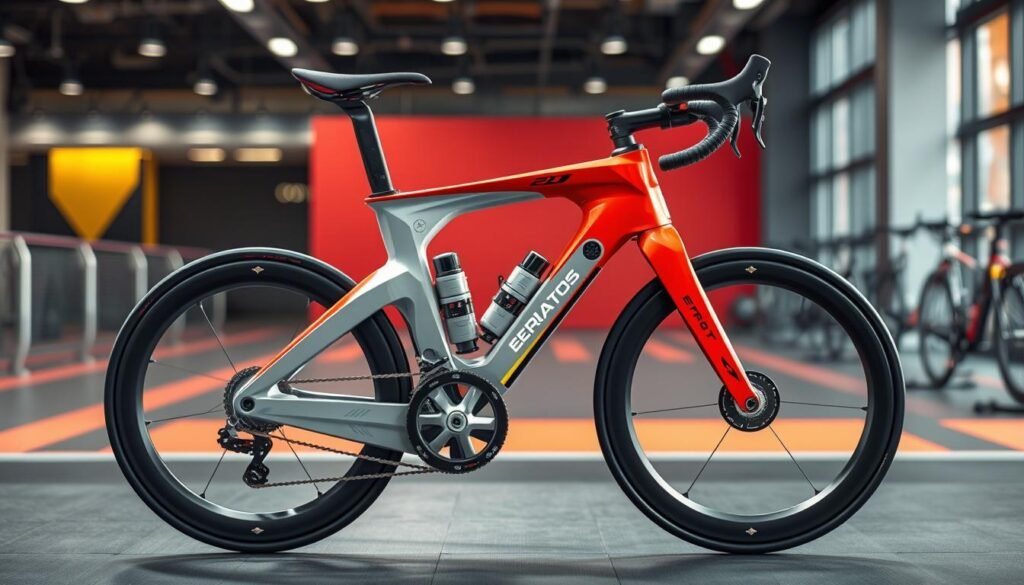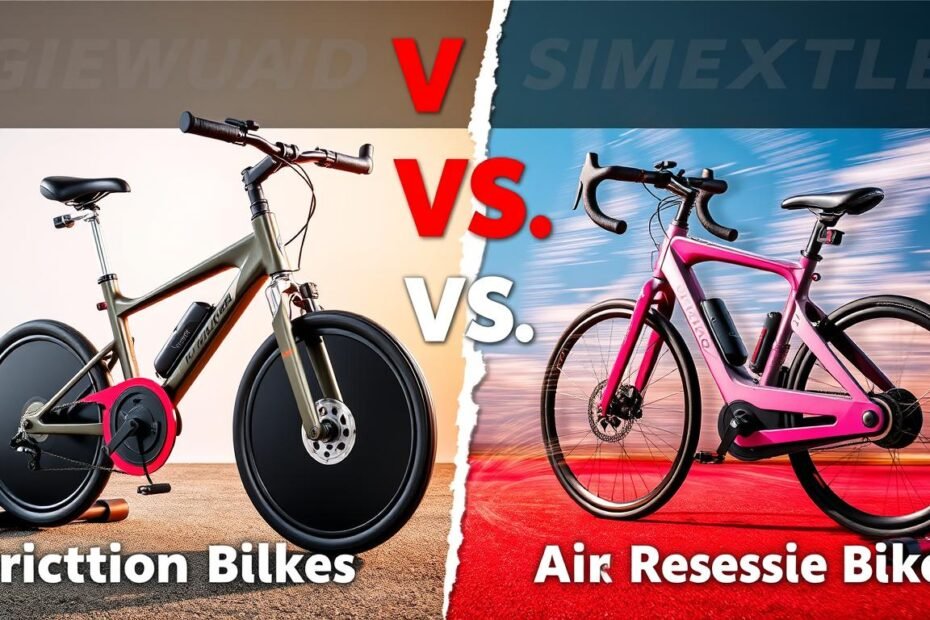Ever wondered why cycling feels different on different terrains or in different weather? It’s because of two invisible forces: friction and air resistance. These forces affect your speed and how much energy you use.
Indoor cycling shows this battle in exercise bike design. Friction bikes use traditional brakes, while air bikes use a fan for resistance. Each type suits different workout styles.
Knowing about these forces helps cyclists improve their efficiency. Whether on a stationary bike or the open road, the rules are the same. By mastering friction and air resistance, cyclists can perform better and enjoy their rides more.
We’ll dive into the physics of cycling to see how these forces impact your ride. We’ll also share tips to improve your performance. From aerodynamic bikes to smart training, we’ll help you overcome friction and air resistance.
Understanding the Physics of Resistance in Cycling
Cycling efficiency is a mix of forces that riders must understand. We’ll explore the physics of resistance in cycling. This includes how different factors affect a cyclist’s performance.
The Basics of Drag Forces
Drag forces are the main challenges cyclists face. At high speeds, aerodynamic drag becomes the biggest obstacle. It grows faster as speed increases. This is why aerodynamic positioning is key for cyclists wanting to go faster.
How Friction and Air Resistance Affect Cyclists
While air resistance is the big challenge at high speeds, friction is also important. Rolling resistance from tires and drivetrain friction can slow cyclists down. Keeping tires at the right pressure and maintaining the bike are crucial to reduce these effects.
The Role of Density and Viscosity in Resistance
Air density and viscosity affect the resistance cyclists face. These factors change with altitude and temperature, impacting performance. Wind tunnel testing helps cyclists adjust their gear and position for different conditions.
| Factor | Impact on Cycling | Optimization Method |
|---|---|---|
| Aerodynamic Drag | Increases exponentially with speed | Body positioning, aerodynamic gear |
| Rolling Resistance | Affects efficiency at all speeds | Optimal tire pressure, surface choice |
| Drivetrain Friction | Constant energy loss | Regular maintenance, lubrication |
| Air Density | Varies with altitude and temperature | Adaptation of strategy to conditions |
Knowing these physics principles helps cyclists make better choices about their gear and technique. Power meters give real-time data. This lets riders adjust their efforts to improve cycling efficiency on different terrains and conditions.
Friction Resistance: The Ground-Level Challenge
Friction resistance is key in cycling, affecting how well we perform and train. It happens when our tires hit the road. This resistance, or rolling resistance, affects our speed and how much energy we use.
When we train, we often forget about rolling resistance. But it’s a big deal for our speed and energy use. For example, it takes about 300 watts to ride at 25 mph. To hit 30 mph, we need over 60% more power!
| Bike Type | Resistance System | Levels | Price |
|---|---|---|---|
| Spin-style (Schwinn IC4) | Magnetic | 100 | $999 |
| Exercise (NordicTrack Commercial VU 29) | Magnetic | 24 | $899 |
Magnetic resistance systems, like those in spin-style bikes, increase resistance as we speed up. This is similar to riding outdoors, where faster speeds mean more resistance. These systems help us improve our pedaling during training.
Air Resistance: The Invisible Barrier
As cyclists, we often underestimate the impact of air resistance on our performance. This invisible force becomes a formidable opponent, especially at higher speeds. Aerodynamic bikes are designed to combat this barrier, but understanding the physics behind it is crucial for every rider.
Pressure Drag and Its Impact on Cycling
Pressure drag is the main cause of air resistance in cycling. At speeds over 30 km/h, air pressure increases significantly, creating a wall of resistance. For every kilometer per hour increase in speed, air resistance triples! This explains why pushing from 25 to 30 mph feels so much harder than from 15 to 20 mph.
The Formation of Turbulence Behind Cyclists
As we ride, we create a wake of turbulent air behind us. This turbulence increases drag and makes it harder to maintain speed. The shape of our body and bike greatly influences this effect. That’s why professional cyclists adopt such extreme positions on their bikes – they’re trying to minimize this turbulence.
Wave Drag and Its Effects at High Speeds
At very high speeds, wave drag becomes a factor. This type of resistance is related to the formation of shock waves around the cyclist. While it’s not a significant concern for most riders, it’s a crucial consideration in wind tunnel testing for top-level competitors and aerodynamic bike designers.
Understanding these forces helps us appreciate the importance of aerodynamics in cycling. Whether we’re weekend warriors or professional racers, knowing how to work with – rather than against – the air can significantly improve our performance on the bike.
Friction Bikes vs Air Resistance Bikes: A Comprehensive Comparison
Choosing between friction bikes and air resistance bikes can greatly affect your cycling workout. We’ve compared these two types to help you decide.
Friction bikes, also known as spin bikes, are great for small spaces. They’re low-impact, making them ideal for recovering from injuries or improving heart health. These bikes have magnetic resistance, offering a smooth and quiet ride.
Air resistance bikes are larger and more versatile. They work your whole body, engaging muscles in your upper and lower body. The resistance gets stronger as you pedal faster, perfect for intense workouts.
| Feature | Friction Bikes | Air Resistance Bikes |
|---|---|---|
| Size | Compact | Bulky |
| Workout Type | Lower body focus | Full-body |
| Resistance Type | Magnetic | Air |
| Noise Level | Quiet | Noisy |
| Price Range | More affordable | Generally pricier |
Friction bikes are perfect for those who value ease of maintenance and space. Air resistance bikes, however, offer more intensity and calorie burn. Your choice should depend on your fitness goals, available space, and budget.

Strategies for Overcoming Friction Resistance in Cycling
Friction resistance is a big deal in cycling. We’ll look at ways to cut down on rolling resistance and make your ride better.
Optimizing Tire Selection and Pressure
Choosing the right tires is key to less rolling resistance. Go for tires with lower resistance compounds and the right tread for your ride. Keep your tire pressure just right for comfort and speed.
The Importance of Proper Bike Maintenance
Regular bike upkeep is vital to fight friction. Make sure your drivetrain is clean and well-lubed. Also, check and tweak your wheel bearings often. A well-kept bike cuts down on mechanical resistance, which is 5-6% of all cycling losses.
Techniques for Efficient Pedaling
Learning to pedal efficiently can save a lot of energy. Aim for smooth, round pedal strokes and keep a steady pace. A bike that fits you right helps transfer power better and cuts down on friction.
| Resistance Factor | Percentage of Total Resistance |
|---|---|
| Air Resistance | 43% |
| Weight/Gravitational Forces | 38% |
| Tire Rolling Resistance | 11% |
| Mechanical Resistance | 5-6% |
| Braking on Descents | 1-2% |
By using these tips and training to reduce resistance, you can boost your cycling performance and efficiency a lot.
Aerodynamic Innovations: Battling Air Resistance
In the world of cycling, new ideas have changed how we seek speed and efficiency. Aerodynamic bikes and design changes are key to top performance. Elite cyclists use wind tunnels to improve their gear and skills.

The effects of these changes are huge. At 20mph, cyclists spend 80% of their energy fighting wind. By lowering their body, riders can cut their effort at 22mph from 340 watts to 170 watts. This shows how important aerodynamics is in cycling.
Computational fluid dynamics has been a big help in making cycling gear more aerodynamic. This tech lets designers test and improve airflow around bikes and riders. It has led to new frame designs, wheel tech, and riding gear.
| Component | Aerodynamic Benefit |
|---|---|
| Aerodynamic Frame | 1.5 to 2.5 minutes saved over 40km |
| Deep-Rimmed Wheels | 1 to 1.75 minutes advantage, 15-30 watts saved |
| Optimized Fork and Front Wheel | Up to 1 second per mile improvement |
These new ideas aren’t just for pros. They help amateur cyclists too. By picking the right gear and using the right techniques, all riders can ride faster and more efficiently.
The Role of Cyclist Positioning and Technique
Cyclist positioning and technique are key to better cycling. Getting your body right and using smart riding tips can cut air resistance. This makes your rides more efficient and fun.
Body Positioning for Minimal Drag
Aerodynamic drag is a big part of the force you feel when pedaling. Changing how you sit on your bike can really help. For instance, leaning forward can reduce drag by 14%. Sitting low on the top tube can even cut it by 32%.
The Art of Drafting in Cycling
Drafting is a smart way to beat air resistance. Riding close behind another cyclist can cut your effort by up to 30%. This trick is used by pros and can help in group rides too.
Training Methods to Improve Aerodynamic Efficiency
Cycling training is more than just pedaling. It’s about getting your body to stay in aerodynamic positions. Exercises for your core and flexibility are crucial. Also, making small changes to your bike fit can make a big difference.
| Training Focus | Benefits | Example Exercises |
|---|---|---|
| Core Strength | Better stability in aero position | Planks, Russian twists |
| Flexibility | Improved comfort in low positions | Yoga, dynamic stretching |
| Bike Fit Optimization | Reduced drag, increased power | Professional fitting session |
Even small tweaks can lead to big improvements. Pro cyclist Ivan Basso cut his drag by 11% with just a 1.5 cm saddle raise and 5 degree arm angle change. With regular training and bike fit tweaks, you can become more aerodynamic and efficient too.
Conclusion: Balancing Friction and Air Resistance for Optimal Performance
We’ve looked into the main differences between friction and air resistance in cycling. We’ve found key insights to boost cycling efficiency. Our exploration of friction bikes vs air resistance bikes has uncovered interesting facts.
Did you know that air resistance makes up 40-50% of the challenges faced by road cyclists? That’s a big obstacle! Meanwhile, rolling resistance adds 10-15% to the total resistance. These figures show how crucial it is to tackle both types of resistance for the best results.
We’ve seen new ideas like carbon wheels, which are 30-50% lighter than aluminum. They often have deep rims of 50-90mm to cut through air resistance. Wider tires are also becoming popular for better grip and handling on bumpy roads. By adopting these innovations and improving our riding skills, we can overcome friction and air resistance. This will lead to a more efficient and fun cycling experience.
FAQ
What is the difference between friction bikes and air resistance bikes?
Friction bikes mimic the resistance from surfaces, like tire-road contact. Air resistance bikes focus on air drag, which grows as speed increases.
How do density and viscosity affect cycling resistance?
The medium a cyclist moves through affects resistance. Air is less dense and viscous than water, making cycling easier. But, air resistance grows as speed increases.
What is rolling resistance, and how does it impact cycling efficiency?
Rolling resistance is the force opposing a bike’s tires on a surface. It’s influenced by tire pressure, type, and road conditions. Reducing it boosts cycling efficiency and performance.
How does pressure drag affect cyclists?
Pressure drag is air resistance from pressure differences on a cyclist’s body or bike. It creates a turbulent wake, increasing drag and reducing efficiency.
What is wave drag, and how does it impact cycling at high speeds?
Wave drag occurs at or near the speed of sound. In cycling, it limits speed, making it hard to go faster beyond a certain point.
What are some strategies for minimizing friction resistance in cycling?
To reduce friction, choose the right tires and maintain proper inflation. Keep your bike in good condition and pedal efficiently. Proper bike fit also helps minimize friction and improve performance.
How do aerodynamic innovations in cycling equipment help combat air resistance?
Innovations in bike design, wheels, and gear reduce air resistance. These are tested in wind tunnels to improve airflow and cut drag.
What is the importance of proper body positioning in reducing drag while cycling?
An aerodynamic body position is key to reducing drag. Lowering the torso, tucking elbows, and maintaining a streamlined profile all help cut drag forces.
